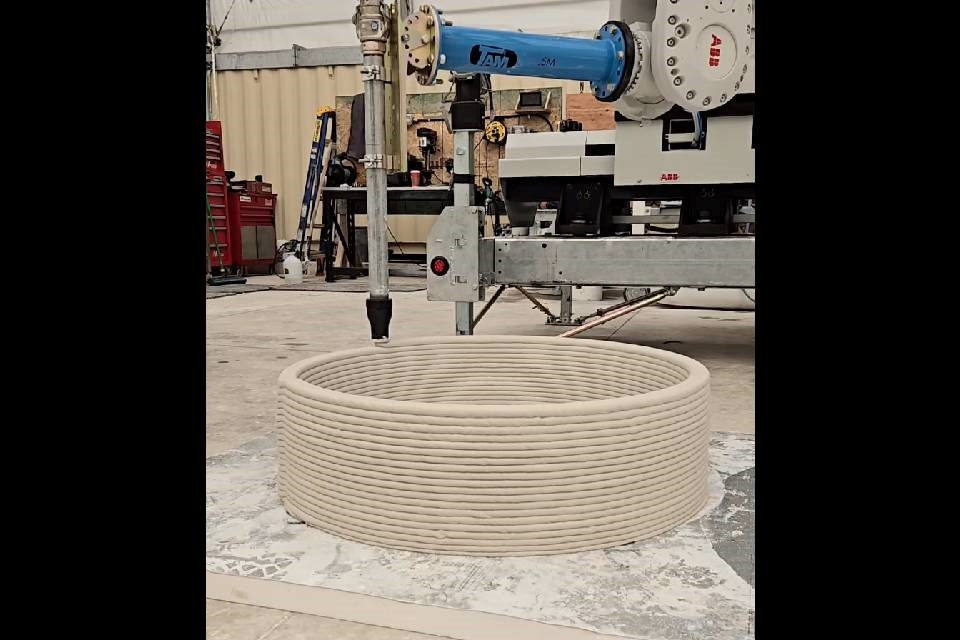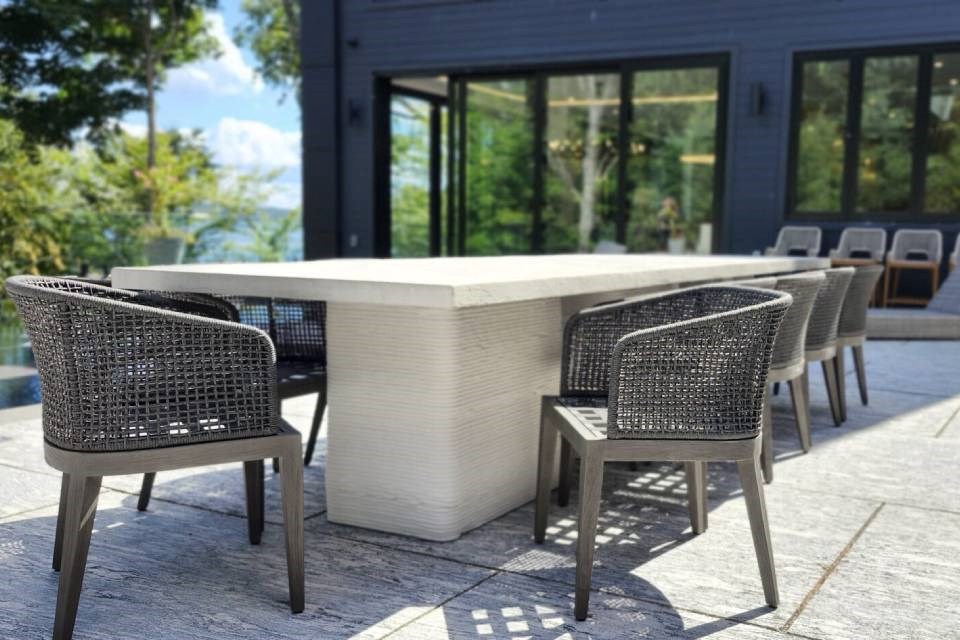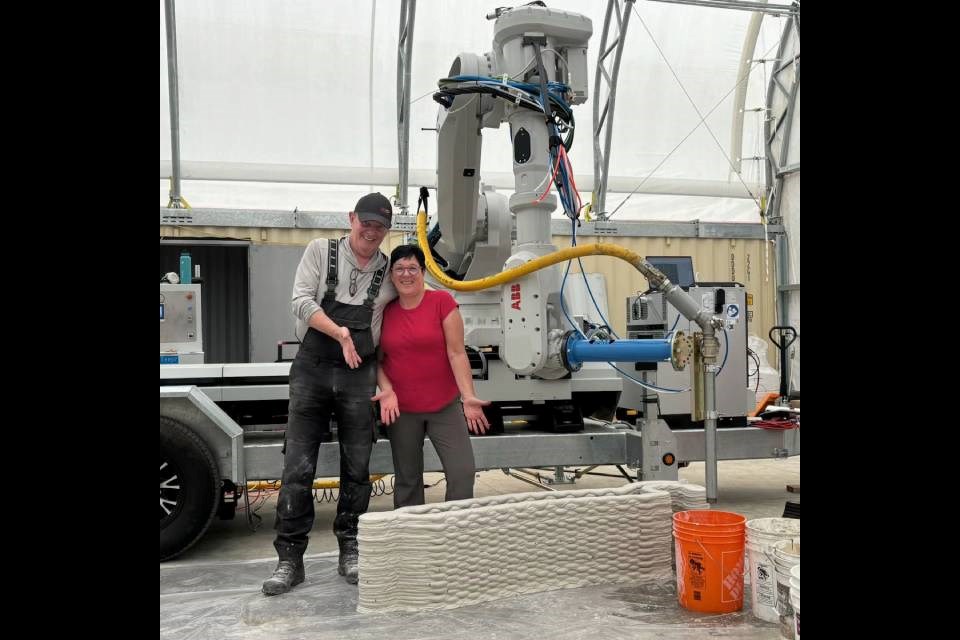Linda Reisman knows only too well how unaffordable home ownership has become for the average Canadian.
She saw it as a volunteer working with low-income families in Muskoka who couldn't find economical places to live.
And she experienced it first-hand after buying property during the COVID pandemic, only to have rising costs put on hold her plans to build a home.
But that got her thinking: if constructing homes by traditional methods is beyond most people's means, why not print them?
Reisman is the owner, cofounder and CEO of the newly launched company 3D Concrete Printing Muskoka (3DCP Muskoka), which was established to create houses, furniture and other architectural design products using a robotic 3D concrete printer.
“There is just so much need for affordable and attainable homes that I decided to go into 3D printing, because I believe that I could help in this area,” Reisman said.
“Really, the sky's the limit with this robotic arm and with 3D printing.”
She brings a variety of skills to the project: as a business owner, event designer, store manager, and a sales director.
Her partner in life and in business, Zohar Klevan, serves as the company's chief technology officer through his master's degree in industrial design, and decades of experience.
The company is looking to forge partnerships with developers or builders that want to use 3D-printing technology on their builds. A developer would provide the building and design expertise, while Reisman's company would provide the equipment and execute the build.
The process goes like this: a specialized concrete mixture is pumped into a robotic arm that's digitally programmed to lay down layers in a specific pattern. As the layers build, walls form, leaving room for amenities like electrical and plumbing to be added as it goes.
Reisman's arm can even read the topography of an area and adapt the design so that blasting rock isn't required. The house can be printed right onto the rock and secured there.
Mounted atop a travel trailer, the 14,000-pound printer takes just a few hours to mobilize, meaning Reisman and her crew can, and will, travel anywhere to print a home.
“We'll to go North Bay, we'll go to Sudbury, we'll go to Timmins. We're all about that,” she said. “You can be rest assured if somebody has a project, we'll be happy to come out.”
The technology has a lot of benefits. It's generally considered to be cheaper than a traditional build, it leaves behind less waste, it requires fewer workers, and it takes far less time to build.
According to numbers from Reisman's website, the walls of a 2,000-square-foot 3D concrete-printed home can be completed in roughly 72 hours.

Although the concept of 3D concrete printing homes has been around for decades, in some regions, it's still a nascent methodology. Reisman said her company is one of only six across Canada that are currently exploring this as a viable building alternative.
Because this country tends to lag in adopting new technologies, Reisman said she spends a lot of time educating people on how it works and advocating for its benefits.
That includes convincing legislators that “we're not reinventing the wheel” when it comes to using concrete as a building material. It's been in common use for hundreds of years. They're simply applying it in a new way.
“There needs to be some changes [to the building codes], but really it's just with regard to the materials being accepted,” Reisman said, noting that 3D-printed homes do exist in Ontario.
“It's just a matter of working with engineers and architects that are able to take our method and translate it into 3D printing so it meets the codes.”
The raw material is actually more than just regular concrete. Reisman didn't detail where she sources her material, but generally, 3D printers use concrete as a base, adding plasticizers, polymers, clays, sand, or fibres to give the material strength and stability.
Eventually, she said, she'd like to be able to create her own raw material, using products found in the environment, “which will be attainable in the near future.”
Her robotic arm, its computer and the software used to program projects were all built in Canada. Reisman said she's sourcing a new print head from the Netherlands, where 3D concrete printing technology is more advanced.
"We're trying our best to produce in Canada, but because of the technology, we have to source a few other things,” Reisman said. “But it hasn't been from the United States.”
It's been about four years since she and Klevan first embarked on this journey. With the exception of a repayable loan, Reisman has funded the entire venture herself.
That means her own dream of home ownership has been put on the backburner while she gets her business off the ground.
To date, 3DCP Muskoka has printed furniture, planters, and other home décor projects. But with plans in the works, and her new printing head set to arrive in April, Reisman expects business to take off this spring.
She's recently secured a building in Bracebridge that will become her business headquarters. It will also serve as both a research and development facility, where she can work on new ideas, and a showroom where she can bring interested developers, politicians or members of the public to see the printer in action.
Reisman is currently in talks with a local developer to build a proof-of-concept home and has been in contact with Indigenous communities seeking alternatives for affordable housing. She plans to 3D print a model home for her showroom so people can visualize what a full-sized house might look like.
“Seeing is believing, right?”

Her ultimate goal — other than 3D-printing her own home on 21 acres in Gravenhurst — is to build a community of affordable, 3D-printed houses that would be available for regular families to live in.
Reisman believes that 3D concrete printing can revolutionize the residential construction industry, as long as people believe in the concept and start putting in place the pieces to make it happen.
“We're not builders. We just want to collaborate with builders or developers that want to use our technology to make their projects more efficient, more cost-effective, more sustainable, and more creative,” she said.
“We are highly motivated and really believe in what we're doing, and we just want to help in the long run.”




